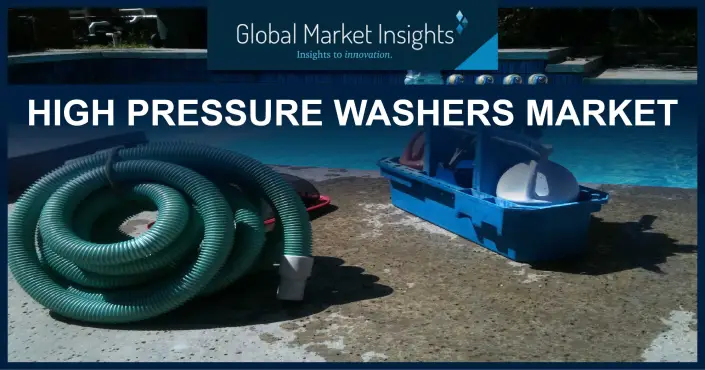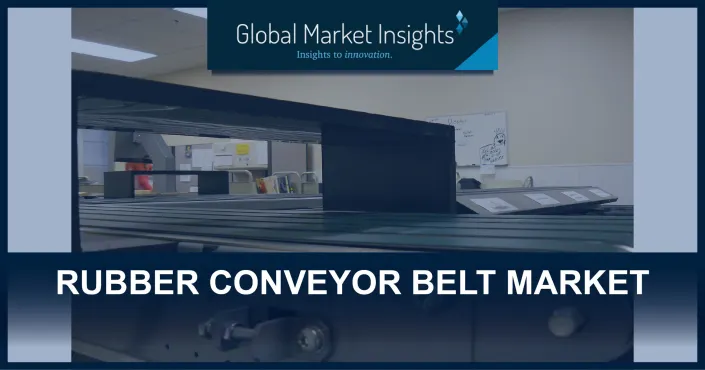Growing agricultural and residential applications to foster high pressure washers market size
High pressure washers market is likely to gain remarkable traction driven be cleaning requirements in construction, commercial vehicle cleaning centers, oil & gas, mining, janitorial, food & pharmaceuticals, municipalities and residential applications.
High pressure washers (HPW) are one of the most efficient mechanical cleaning equipment used as water sprays to remove dirt, mud, dust, grime, graffiti and paint from surfaces of machines, floors and walls. The equipment is used across various industries ranging the from commercial vehicle cleaning to food & beverages sector. Some pressure washers are also used for industry cutting tools in manufacturing sector. HPWs are available in extensive range of power, hose design, water temperature variants for a number of uses.

Escalating demand for cleaning equipment in food industry may result in the product proliferation. Moreover, increasing cleanliness standards in industrial, commercial, and residential settings will favor the equipment deployment in the coming years. Globally, high pressure washers market size is forecast to surpass USD 3.1 billion by 2026.
Portable HPWs are witnessing major demand due to advantageous product attributes including easy mobility, easy handling and compact design. Most of the portable pressure washers come with 4 or 2 wheels for maneuvering. The greatest advantage of using this product is its capacity to allow user to clean difficult to reach spaces such as high walls or under trucks. Portable high pressure washers account for a large portion of the product sales and revenue generation.
High pressure washers with under 1500 PSI pressure are used for janitorial applications and households, where a limited force of water is suitable for everyday cleaning purposes. The product is ideal for use by commercial and homeowners for regular cleaning processes. HPW units under 1500 PSI will exhibit a notable growth in demand over the projected timeframe.
Get a Sample Copy of this Report:@ https://www.gminsights.com/request-sample/detail/4601
Hot water pressure washers segment in the market is forecast to showcase growth rate of more than 3.1 % through 2026. These washers commonly find usage in industries to remove greasy stains form vehicles surfaces or equipment, mainly in construction, manufacturing, oil & gas and mining sector.
HPWs are majorly experiencing demand for application in agriculture, oil & gas and mining industry. These washers are proven to be highly efficient mechanical machines for mining and oil & gas industries for the cleaning of complex machinery parts, drillers, boring machines, vehicles etc. It easily removes mud and grease, that further aids in easy maintenance of these equipment and tools. In agriculture, high pressure washers are utilized for cleaning farm equipment and vehicles such as tractors.
Europe high pressure washers market share is likely to gain remarkable traction majorly due to expanding cleaning equipment sector across the region. Countries such as Germany are already spending significant resources to clean its public space and surrounding environment.
Prominent players in the global high pressure washers market are Alfred Karcher GmbH & Co, Briggs & Stratton corporation, FNA Group, Nilfisk A/S, Graco, Bosch, Stanley Black & Decker, John Deere, Kranzle, The Tennant Company, Techtronic Industries Co. Ltd, and AR Blue Clean, among many others.
Author Name : Aakriti Kakkar
Continuous shipbuilding activities to complement floating docks market forecast
Presently, floating docks industry is gathering commendable profits. However, stringent regulations imposed by regulatory bodies to reduce environmental impact may stall industry growth. Construction of these led to release of toxins or contaminants in the environment, which could potentially harm the marine ecosystem. Moreover, ban or prohibition on use of various harmful chemicals are further compelling manufacturers to alter and streamline their manufacturing process as per environmental standards.

To abide with regulatory laws, these manufacturers are supposed to conduct various expensive tests and procedures such as TCLP (Toxicity Characteristic Leaching Procedure) to check the environmental feasibility of floating docks. These tests will incur extra costs and increase overall production value.
Plastics & composite decks industry is expected to account for more than 15% of the total volume share over the analysis period. These decks are made by combining plastic and wood fibers. Plastics & composites deck offers a long service life and requires less maintenance. Also, these decks offer premium wood looks, enhancing the overall aesthetics.
Get a Sample Copy of this Report:@ https://www.gminsights.com/request-sample/detail/4586
Concrete framing is primarily used for heavy duty marine projects and often provided with concrete floats and concrete decks owing to high strength requirements. Concrete frames segment will contribute over USD 15 million towards the floating docks industry share by 2026.
Metal floats are available in the form of tubes or drums and are commonly made of aluminum. The product offers various advantages such as long life, durability, operational capacity and exceptional strength. As per estimates, metal floating docks are expected to cross installation numbers of 6,500 units by 2026 worldwide.
Flourishing marine tourism creates huge potential for the residential segment over the next few years. The segment’s growth will be majorly influenced by increasing consumer inclination towards recreational activities. Key manufacturers of floating docks are Jet Dock Systems, Inc., Bellingham Marine, Meeco Sullivan, Obrascón Huarte Lain, S.A., Damen, Walcon Marine, Candock, PMS Dockmarine and AccuDock.
These manufacturers are adopting various organic and inorganic strategies such as merger & acquisition and capacity expansion to gain competitive edge over other industry players. Moreover, they are entering partnerships and collaborations to reinforce their market hold across different geographical landscapes.
Author Name : Aakriti Kakkar
4 prominent factors influencing elevator ropes market forecast
Prominent global market players include Bharat Wire Ropes Limited, Loos &Co. Inc., Jiangsu Safety Steel Wire Rope Co. Ltd. and Gustav Wolf GmbH, among several others. Mentioned below are some the notable factors that may impact global elevator ropes market revenue growth in the coming years:
Urbanization in Europe
Increasing number of high-rise buildings and skyscrapers in regions such as Europe will propel the developments in elevator ropes industry. Comparatively high disposable income among people in the region is steering the demand for advanced residential buildings that are technologically equipped.

Reports estimate that, by the end of 2026, Europe elevator ropes industry size will be valued at USD 200 million. Increasing repair and maintenance of elevators in Europe is another prominent factor amplifying the demand for the products in the region.
Get a Sample Copy of this Report:@ https://www.gminsights.com/request-sample/detail/4584
Demand for hydraulic elevator
Hydraulic elevators have gained widespread traction over the years due to their cost-effectiveness as compared to other alternatives. By 2026, hydrauhlic elevators segment is expected to account for 15% of the total elevator ropes market share. They are widely found in low rise buildings across the emerging nations in Asia Pacific.
Machine room-less elevators are showing unprecedented demand due to the increasing space constraints for the building owners. The growing presence of buildings particularly in the urban areas has led to the construction of cramped building owing to less space. Reduced cost of installation and maintenance is a major factor complementing the adoption of these elevators.
Wide variety of elevator ropes
Fiber core elevator ropes are witnessing demand due to their ability to provide superior resistance against contact pressure and superior flexibility in handling. FC elevator ropes comprise of superior flexibility and provide resistance to contact pressure. The wire core is mainly made of synthetic or natural fiber materials.
Governor ropes act as a safety mechanism during the fast movement of an elevator cabin. As per reports, by the end of 2026, governor ropes are expected to generate a market revenue of over USD 100 million.
Industrialization in Asia Pacific
Increasing establishment of foreign companies in regions such as Asia Pacific due to FDI inflow and the availability of relatively cheaper cost of labor and raw material is propelling regional demand for commercial and industrial complexes. Consistent demand from such projects will foster elevator ropes industry trends.
Comparative improvement in the rate of affordability among people in countries like China, India, Singapore, Japan, and Thailand is leading to the construction of tall buildings and skyscrapers. Moreover, an increase in tourism in the region is resulting in the establishment of hotels and other forms of accommodation, driving the need for robust elevator solutions.
Author Name : Shreshtha Dhatrak
Growing demand from construction sector to bolster forestry equipment industry trends
Forestry equipment is widely utilized for making wood chips, cutting trees, delimbing, and dragging woods to certain locations. Increasing investments in R&D for the development of wood-based innovative products is propelling the demand for forestry equipment. Moreover, wood-based panels such as particleboard, plywood, Oriented Strand Board and fiberboard are in high demand and will thereby augment the adoption of equipment for raw material harvesting.
Get a Sample Copy of this Report:@ https://www.gminsights.com/request-sample/detail/4580
Focus towards vegetation conservation, management and restoration of national forests is gradually increasing. The government authorities across the United States are largely supporting timber harvesting or regeneration treatments to stabilize the ecosystem. Rise in number of natural calamities has instigated government authorities to undertake reforestation initiatives to protect affected watersheds. This is likely to create a massive demand for forestry equipment.
Chippers are expected to experience major adoption owing to increasing demand for wood chips in construction, as fuel & composting materials and for erosion control. Wood chips and other organic matters such as grass cuttings and dead leaves act as excellent fertilizers. The emergence of organic farming has created huge demand for processed wood chips.
To cater to the growing demand, manufacturers in the forest equipment market are launching affordable self-propelled chippers for speedy and efficient functioning. For instance, Alle Rechte vorbehalten in 2019 launched a self-propelled chippers variant, equipped with an engine having 612 – 768 horsepower.
North America is likely to emerge as a profitable revenue terrain for forestry equipment industry owing to mounting demand for saw logs and roundwood from the region. Major players across the region are launching new products equipped with advanced engines, better safety features, efficiency and high productivity. For instance, in 2017, Hitachi planned to launch a new forestry equipment in North America. The machine featured a Stage IV Isuzu engine which would aid in enhancing productivity while lowering maintenance costs.
Key players operating in the forestry equipment market are Caterpillar, Komatsu Ltd., Deere & Company, AB Volvo, Doosan Infracore Co. Ltd., Barko Hydraulics LLC, JCB, Liebherr Group, Bell Equipment, Hyundai Heavy Industries Co. Ltd., amongst others.
With increasing consumption of wood-based products in infrastructure development, the forestry equipment rental service is rapidly growing across the North American region. Leading businesses such as Caterpillar & Deere, are providing forestry equipment rental services to cater to the mounting demand. For instance, in August Komatsu appointed TEC (Tractor & Equipment Company) in 2019 as its distributor in North America region.
Author Name : Aakriti Kakkar
Ongoing grid retrofitting and refurbishment activities to foster the global substation market outlook by 2026
With ongoing industrialization focusing on fostering overall economic growth in a positive manner with help from foreign direct investments to support commercial and industrial establishments would also boost the demand for primary as well as secondary electric distribution infrastructure.
Additionally, rapid digitalization throughout industrial establishments has substantially integrated a competitive industry scenario, primarily due to the growing energy demand from data centers and communication base stations. The rising adoption of reliable, advanced, fire-resistant, energy efficient and reliable electric equipment has established a positive business scenario.
As per a research report by Global Market Insights, Inc., global substation market is estimated to surpass an annual installation of 24,500 units by 2025.
Utility aided by electrical infrastructure has been positively influenced by government and regulatory directives subject to the deployment of the grid. Regulatory schemes relating to the rural electrification along with the inclusion of decentralized micro-grid infrastructure throughout standalone regions have augmented the product penetration.
Furthermore, establishment of energy networks that are sustainable and are supported by investments from regulatory authorities and local institutions like the IFC, World Bank and other similar organizations throughout developing nations may positively influence the industry dynamics.
Get a Sample Copy of this Report:@ https://www.gminsights.com/request-sample/detail/4485
With respect to voltage level, low & medium voltage substations that are up to 145 kV have achieved a substantial thrust owing to rapid commercial expansion and large-scale residential applications throughout developing nations in recent years.
Moreover, the suburban migration has also led to the development of residential complexes as well as multi-story apartments, thereby accelerating the industry growth. Furthermore, encouraging consumer as well as regulatory inclination for incorporating sustainable electricity networks would further encourage industry growth.
On the geographical front, the United States substation market is set to foresee a 5% growth by 2026. Growing demand for effective transmission & distribution infrastructure coupled with an increase in commercial and industrial investment would stimulate the business growth.
Moreover, government initiatives to promote technologies of substation automation & monitoring control systems backed by strict regulatory norms might further influence the industry share. The U.S. utilities, which includes cooperatives, public power providers and utilities that are investor owned, invested around $4.8 billion back in 2016 in smart grid control systems and technologies.
Additionally, ongoing industrial development and large-scale suburbanization throughout APAC and MEA have led to significant increase in demand for substation systems.
Overall, the above-mentioned factors are likely to offer a wide array of growth opportunities for substation market.
The competitive spectrum of global substation market includes companies like Siemens, Emerson Electric, ABB and Eaton among others. These prominent players are also employing strategic alliances with technology providers to execute effective monitoring & control.
Author Name : Nandita Bhardwaj
Industrial air compressor market to record substantial gains from oil-filled compressor segment over 2019-2026
Ever-increasing manufacturing activities commenced across developing nations have accelerated the demand for industrial air compressor in recent years. Industrial air compressors are widely used across manufacturing sectors like heavy engineering products, steel fabrication, automotive production, energy & mining, pharma, food & beverage, and others. With profound application across such several end-use sectors, the industrial air compressor market is anticipated to accrue prominent growth over the forecast period.
Technological advancements in pneumatic equipment like actuators, robotic arms, and assembly lines would generate lucrative growth opportunities for the industrial air compressor market. Global Market Insights, Inc., meanwhile predicts that the industrial air compressor market may surpass USD 24 billion by 2026.

Based on lubrication, the oil-filled air compressor segment has registered immense application in the manufacturing sector owing to its minimum cost and robust application advantages over oil-free alternatives. These compressors are used across nuclear, hydroelectric and thermal power plants. The oil-filled industrial air compressors are regularly employed in drilling, mining, and quarrying activities to power pneumatic drilling equipment. With growing applications in numerous industries, studies suggest that the oil-filled industrial air compressor industry may surpass over USD 10 billion by the year 2026.
As per technology, the market is classified into reciprocating, rotary, and centrifugal air compressors. Out of these segments, rotary air compressors are slated to be good energy conservers and can generate less heat compared to other air compressors. They are also renowned for consuming less oil. In 2018, rotary air compressors market was accounted for over 55% of the market share. Moreover, with growing prominence, it is estimated to witness significant traction over the forecast period.
Get a Sample Copy of this Report:@ https://www.gminsights.com/request-sample/detail/4474
On a regional front, APAC is expected to generate lucrative growth opportunities for the industrial air compressor market. The region has witnessed rapid industrialization over the past few years. In 2018 alone, the regional market accounted for approx. 40% of the global output.
Activities like construction, manufacturing, and mining in the region are shaping the growth trajectory of the market. All these factors are slated to significantly drive APAC industrial air compressors industry expansion in the forthcoming years. However, stringent emission norms could restrain the size of industrial air compressor market in APAC.
Reportedly, the industrial air compressor market is fragmented with the presence of prominent manufacturers like Doosan Portable Power, Mat Holdings, Quincy Compressor, Hitachi, Rolair Systems, Sullivan-Palatek, Gardner Denver, Elgi Compressors, Atlas Copco, Ingersoll-Rand, Kaeser Kompressoren, Bauer Compressors, Sullair, Ciasons Industrial, Aerzener, and Heyner.
Frontrunners like Gardner Denver, Atlas Copco, and Ingersoll Rand have a strong presence in the global market. Strategies such as subsidiaries and joint ventures have mainly led these firms to attain lucrative growth opportunities.
Author Name : Abhijeet Kakade
Robust demand for Knuckle boom crane slated to spur offshore crane market dynamics
Sustained demand for maintenance & repair of oil & gas extraction systems is poised to fuel offshore crane market size. A notable uptick is being witnessed in subsea construction projects followed by infusion of investments, thereby signifying the relevance of maximum safety and high lifting capacity. Prominently, offshore cranes are highly sought-after in pipe maintenance & repair operations.
Stakeholders anticipate demand for knuckle boom cranes to proliferate against the backdrop of low maintenance and maximum efficiency requirements. These robust cranes find increased application in loading and unloading operations. With knuckle boom cranes providing improved strength and flexibility, they have become popular in marine and oil & gas industries. Meanwhile, lattice boom crane and telescopic boom crane will also provide impetus to the offshore crane market size. Dramatic rise in the construction of new ports & harbors will further boost offshore crane market share during the forecast period 2019-2026.
Offshore crane market size is expected to surpass US$ 5 billion by 2026, according to the latest research report by Global Market Insights, Inc.
With lifting capacity of over 5,000 mt, popularity of heavy-duty offshore cranes is set to spur the demand for the cranes as they apparently perform efficiently in hostile condition. It is prudent to mention that these dynamic cranes are increasingly used in the construction of large oil & gas and windfarm projects in offshore ambience.
North America offshore crane market share is expected to expand robustly in the wake of an upsurge in demand for electricity witnessed in the U.S. Reportedly, the U.S. government is vying to produce maximum electricity stemming from renewable energy sources such as offshore wind. Of late, demand for renewable energy has surged in the backdrop of burgeoning urbanization and rampant population. For instance, in 2019, Vineyard offered an 800 MW wind farm project in Massachusetts to provide electricity to over 400,000 homes with clean energy. Apparently, the company is contemplating investment of around US$ 2.8 billion for development of project.
Government initiatives across India and China aimed at bolstering renewable energy landscape are expected to remain catalyst in fueling offshore crane market revenue during the assessment period. Prominently, attributes such as better vessel stability and light weight make offshore crane highly sought-after among end-users.
Get a Sample Copy of this Report:@ https://www.gminsights.com/request-sample/detail/4103
MEA offshore crane market size is likely to augment during the forecast period as the region is replete with investments. For instance, National Petroleum Construction Company (NPCC) in November 2019 proclaimed an investment of US$ 89.8 million to spur subsea construction projects in the UAE. According to several reports, NPCC is contemplating product expansion as they look to underpin many deep-water projects not only in the Gulf but also across the globe. Meanwhile, high maintenance and operational cost may derail the growth of offshore crane market.
Leading companies are overwhelmingly prioritizing strategic business strategies such as price and product differentiation strategies. Prominent players eyeing for offshore crane market size expansion are Liebherr, Palfinger AG, National Oilwell Varco, Huisman Equipment, Kenz Figee, MacGregor, Seatrax and Heila Group. These companies are increasingly investing in research and development activities to help boost reliability and energy efficiency.
Author Name : Sunil Jha
Flourishing real estate sector to propel U.S. home remodeling market outlook through 2026
U.S. home remodeling market has emerged as one of the most lucrative avenues of investment in recent years. The industry is now set to observe a remunerative growth trend in the coming years. This development can be accounted for growing customer expenditure on homes. In addition, a rapidly growing real estate sector would likely further outline the market expansion through 2026.
Apart from the growing real estate, surging inclination of homeowners towards luxurious and energy-efficient living spaces would majorly contribute to the development of overall market outlook. In fact, people with homes in major states of the U.S. like Florida, Texas and California spend heavily on home renovation.
Citing an instance, as per the NAHB (national association of home builders), in 2018, the expenditure per improvement within California was more than $9,565, which is almost 20% more when compared to that in 2017.
Get a Sample Copy of this Report:@ https://www.gminsights.com/request-sample/detail/4459
In addition, growing customer awareness regarding environmental protection and energy conservation through the use of green materials would majorly drive the market share in the coming years.
According to a research report by Global Market Insights, Inc., U.S. home remodeling market is estimated to surpass $500 billion through 2026.
Speaking of the end-use segment, kitchen additions and improvements is set to observe substantial growth trend in the coming years. Growing customer preference towards streamlined designs, materials, and textures due to the mounting popularity of farmhouse and mid-century designs would majorly propel the segment growth.
Apart from kitchen improvements, steadily growing need for hardwood flooring would augment the segment growth and thereby drive the market size. In addition, mounting popularity of ceramic tiles would also outline the segment expansion in the coming years.
Meanwhile, growing prevalence of various bathroom fittings like wall-mounted toilets, floating vanities, rounded rectangle vanity mirrors, and console sink vanities would proliferate the market share through 2026.
Additionally, the roofing sector is also set to observe substantial growth outlook owing to rapid technological upgrades and advancements happening every year. Growing emergence of various innovations is also likely to add up to the industry share through 2026.
Apart from the end-use segment, increased growth in the sales of existing homes in the region would majorly drive the market share. Expenditure on home improvements is growing due to rising cost of material and labor, further adding up to the market expansion. Additionally, increased spending of homeowners will also possibly drive the growth of U.S. home remodeling market.
Moreover, growing house rentals is likely to accelerate U.S. home improvements. In fact, as per the Joint Center for Housing Studies of Harvard University, nuclear family homes attributed to 39% of the whole U.S. rental homes.
All in all, rising homeowners’ expenditure, mounting house rentals, the growing prominence of kitchen improvements are likely to facilitate a massive range of opportunities for U.S. home remodeling market players.
The industry is inclusive of players such as Watsco Inc., US LBM, HD supply, Beacon roofing supply, ABC Supply, Ferguson Enterprises, The Sherwin-Williams Company, Pella Corporation, Andersen Corporation, and Kohler Co. among others.
Author Name : Bhushan Tambe
Robust growth of mining sector to boost rubber conveyor belt market forecast
Global rubber conveyor belt market will grow substantially in the years to come mainly due to widespread demand in the mining sector. Ease and convenience of these belts in transportation of bulk materials make them best-suited for a range of open pit and underground mining applications. These belts offer excellent power saving capabilities and can efficiently transfer materials over short, medium as well as long distances, even across topographically difficult terrains with steep angles.The anti-abrasive, heat-resistant, flame-resistant and oil-resistant characteristics of rubber conveyor belts make them suitable for long-distance coal conveying. A growing global population along with robust economic growth is leading to increased utilization of resources such as coal, iron ore and copper, in turn fostering the growth of the global mining sector.
The costs for setting up of rubber conveyor belts in a mine or a plant are a considerably high. Moreover, high maintenance and replacement costs associated with these belts may slightly impede the industry growth in the coming years. However, the fact that these belts substantially reduce labor and transportation costs will present favorable opportunities for conveyor belt manufacturers worldwide.
Global rubber conveyor belt industry share is segmented into textile reinforced belts, steel reinforced belts, and solid woven belts, among others based on materials. Textile reinforced rubber conveyor belts are further classified into performance textiles and commodity textiles. These belts offer excellent dimensional stability and have low moisture absorption.
Textile reinforced belt segment was valued at more than USD 3 billion in 2018. Nylon and polyester blends are generally used to manufacture textile reinforced belt carcasses. This helps them achieve exceptional abrasion and fatigue resistance and ensure high strength and durability.
Get a Sample Copy of this Report:@ https://www.gminsights.com/request-sample/detail/4411
On the basis of application, rubber conveyor belt industry share is classified into light weight, medium weight, and heavy weight. Rubber conveyor belts used for light weight applications generally have lower tensile strengths. These belts facilitate transportation of lightweight materials within a plant, production or a mining facility. Light weight rubber conveyor belt market size is estimated to register a CAGR of more than 3% over 2019-2026.
Rubber conveyor belts are deployed across mining, metal processing, power generation, cement manufacturing, and recycling, among few other end-users. The mining sector is further segmented into coal, metals and others. Mining industry captured over 41% share of global rubber conveyor belt market during 2018 and will continue to be the largest end-user over the forecast timeline.

North America rubber conveyor belt industry will garner revenues in excess of USD 1.5 billion by 2026. The presence of several prominent mining companies in the region will open up promising opportunities for regional manufacturers. The U.S. is also one of the leading mining countries in the world with an extensive range of ferrous and non-ferrous metals which will complement the regional outlook.
Asia Pacific is anticipated to account for a major share of global rubber conveyor belt market forecast. This can be largely attributed to rapid growth of mining, manufacturing, power generation, and recycling industries in the region. Europe will likely record slightly slower growth rate compared to other regions mainly due to increased adoption of renewable energy sources for power generation.
Author Name : Hrishikesh Kadam
